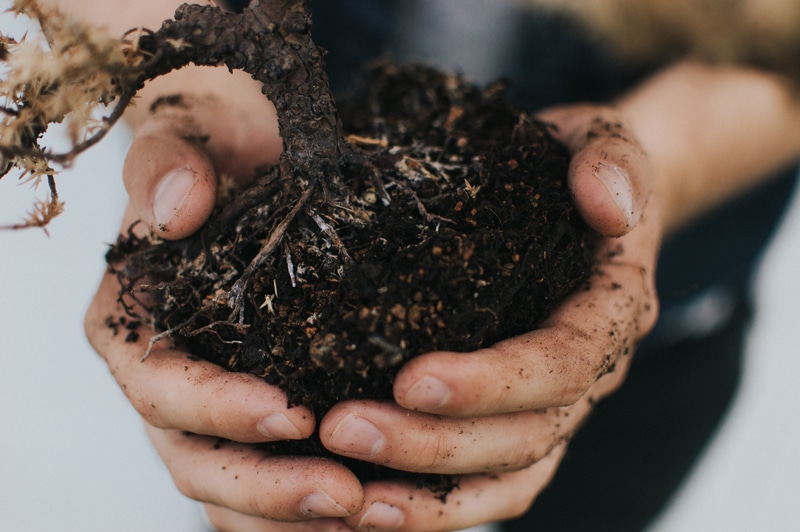There are two best ways to learn how to add iron to soil. Much like knowing how to measure fertilizer to provide plants the nutrients they need, the soil’s quality also plays a significant role in the growth and health of your plants. The iron itself is crucial for plant growth and metabolism, so ensure that your soil can provide this.
There are many reasons why some soils can’t provide enough iron, such as alkalinity, too much calcium in the ground, or having acid-loving plants. To remedy this, you have to amend your soil, so the plants get their iron nutrition at the recommended levels. However, it’s vital to determine the specific cause itself and conduct a soil test before choosing between the two ways below.

How To Add Iron To Soil: 2 Easy Ways
Way #1. Iron fertilizer
The first method on how to add iron to soil is straightforward, and it’s a simple application of iron fertilizer. You can think of this as a quick remedy, especially when you notice that your plants experience yellow leaves. Remember that this could be a telltale sign of iron deficiency.
Chelated iron vs ferrous sulfate
Amending the soil with iron fertilizer should help restore the healthy colors of your plants. Gardeners often apply at a 14-day interval depending on the label instructions. These fertilizers typically use iron chelates and ferrous sulfate, where the former is preferred because this form is readily available for plants for a more extended period.
However, do note that soil testing is essential to know the cause of your soil’s iron deficiency. Those in the greenhouse can take advantage of easier testing because they have a definite location without many environmental changes. If you found that your soil has a high pH level, then you should choose the Fe-EDDHA fertilizer and use two pounds per 100 square feet of soil several times during the growing season.
Of course, this treatment may vary depending on the soil and plants. Otherwise, you can also add organic matter to the soil because it is rich in natural chelates. In the next discussion below, you will also learn that organic matter like compost lowers the soil pH.
Way #2. Lower the soil pH
Amendments
As discussed earlier, soil with a high pH level is prone to being deficient in iron. Keeping this in mind, lowering the soil pH should also help amend the soil’s iron nutrition. A simple way to reduce the soil pH is by adding several amendments ranging from compost, sulfur, urea, ammonium nitrate, and ammonium sulfate.
Acidifying the soil
You can also acidify the soil if it isn’t well buffered. This solution is limited to containers and beds because you get to replace plants frequently in these situations, and you can still incorporate amendments in the soil. The most common way to acidify the soil is by adding elemental sulfur at different rates depending on the soil type.
Signs Of Iron Deficiency
Without soil testing, it will be impossible to know that you need to add iron to the soil to make up for your plants’ deficiency. Therefore, you need to learn some signs of iron deficiency and address this problem quickly. The best way to check is by looking at the newest leaves on your plants if they are stunted and white.
The area in between the veins also tends to turn yellow or white. Some leaves can also show chlorotic lesions. More so, it would be best if you learned what leaf chlorosis is.
Leaf chlorosis is a symptom where the plant’s veins are green, but the leaf itself is yellow. You’ll notice the lesion starting at the tips, and besides, some plants can also experience leaf loss. The emphasis is necessary on noting that the lesions are angular and sharp because rounded lesions are signs of zinc deficiency.
How To Prevent Iron Deficiency
It can be daunting to find out that your soil requires an amendment to provide iron to the plants at the optimal level. However, you can still correct this deficiency using the two methods discussed. You can also prevent iron deficiency altogether by simply adding sulfur when preparing the soil for your plants.
It would also be best to know if your plants will thrive well in your soil as some species would be more susceptible to iron deficiency. For example, if you’re in Arizona, you’re better off using desert plants because they’ll grow well in Arizona soils. Otherwise, some plants may be sensitive and require soil amendments.
Conclusion
It’s not enough to provide the ideal environment, such as using the greenhouse for your plants. You also have to test the soil and learn how to add iron to soil if the plants show signs of iron deficiency. The good news is that after finding the cause of the iron nutrient deficiency, you can quickly amend the soil either with iron fertilizer or other amendments that will lower the soil pH.
Chelated iron is an ideal amendment for the soil because it is readily available for the plants. On the other hand, you can acidify the soil in your containers to lower the soil pH and solve this deficiency. The bottom line is that this problem’s remedy is straightforward as long you test your soil beforehand and determine the cause.
